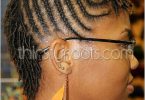While they can be quite time-consuming, cornrow hairstyles for women are well worth the investment. Not only are they exquisitely unique, but they provide both a historical and cultural connection to ancient African civilizations. Evidence also exists that suggests roots Nigeria and Egypt as well. In fact, this practice of tight, detailed braiding can be found on hieroglyphs and sculptures that date back as far as 500 B.C, the most well-known sculpture being the great Sphinx!
These hairstyles are carefully constructed with a tight braid that starts very close to the scalp and woven using an underhand and upward technique. The basic design, then, is to produce straight rows that are either continuous or patterned. These patterns can either be simple and straightforward, artistic and curvilinear, or more complicated. The time and energy you invest in forming them is never wasted because you can leave this hairstyle in for up to a month at a time. You can wash it like you normally would, but you have to apply oil to the rows and the scalp.
While this may sound very practical, these hairstyles can also be designed to be more creative and adorning too. In some African traditions, it was actually very common for some tribes to weave shells or beads into the braiding. The materials they used were those that were found in the regions where they lived, be it coastal or inland.
Although these styles have been around for nearly over a millennium, they didn’t start to become popular in the United States until the 1960’s. This was greatly due to the Black Pride Movement, which not only helped to institute civil rights, but got many black Americans in touch with their African roots leading them to start wearing more traditional clothing and hairstyles.
At the climax of the Civil Rights Movement more African Americans began to explore their culture by starting businesses that celebrated their roots. This cultural revival saw the development of many beauty shops that specialized in celebrating the natural textures and exotic styling African hair.
These shops have become increasingly more important as the need and desire for more exotic cultural hairstyles grew. As such, many people have become specialists in this area, mastering the artful technique that is so widely appreciated. As the black identity in America becomes stronger from an increase in successful African American professionals and entertainers, the need for such cultural practices will likely also continue to grow.



